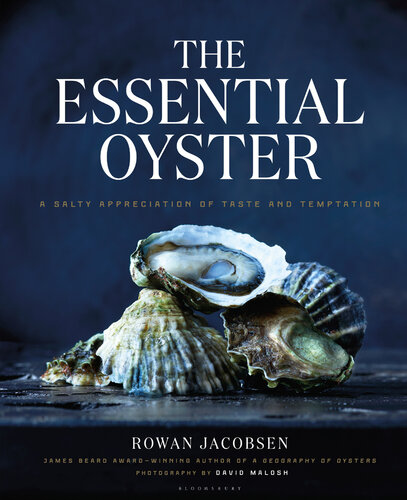
The Essential Oyster
A Salty Appreciation of Taste and Temptation
کتاب های مرتبط
- اطلاعات
- نقد و بررسی
- دیدگاه کاربران
نقد و بررسی

Starred review from June 6, 2016
In the 10 years since Jacobsen’s first shellfish manifesto (A Geography of Oysters), oyster options on menus have expanded at a pace that rivals craft beers. There are now more than 300 varieties farmed or found along the waters of North America. Here, Jacobsen chooses 100 favorites, based on criteria such as historical significance and “flat-out yumminess,” creating an in-depth guide that is also a highly enjoyable read. For each object of desire there is a full-page color photo by David Malosh, and a list of five data points: the species (e.g., Pacific or eastern), how the oyster is cultivated, its physical appearance, its flavor, and its availability. For example, one of the newest delicacies is the murder point, an eastern oyster grown by Auburn University in five feet of water. They are “movie-star handsome” with a cream-of-potato soup flavor and will be produced at a rate of two million a year. Once all this data is dispatched, Jacobsen settles in with a few paragraphs of appreciation for each mollusk. Humorous, crafty, and deeply informative, these passages are the reason to read this book, instead of turning to one of the many oyster apps or websites. Of the Bar Harbor selection, Jacobsen writes that the shells have the “depth and strength of bottom-cultured oysters, but the beautiful purple swirls of bag-coddled bivalves.” A handful of recipes from top chefs round out the book, chased down with a dirty oyster-brine martini.

This verbally and visually succulent book covers 99 types of oysters, most from the shores of North America.Ten years after A Geography of Oysters, James Beard Award-winning author Jacobsen (Apples of Uncommon Character, 2014, etc.) chronicles his travels from British Columbia down to Seattle, across the Gulf Coast, and from North Carolina up to Nova Scotia, with detours to Ireland, France, and New Zealand. There may be, as he notes, only five widely distributed species of edible oysters, but the look and taste of these species vary widely based on the "merroir" (the marine equivalent of "terroir") in which they grow up and the way that they are treated as they grow. The author's appreciation of even the least prepossessing of these bivalves is infectious. Jacobsen makes the case that "every oyster is a tide pool in miniature, a poem built of salt water and phytoplankton that nods to whatever motes of meaning shaped it." The lavishly illustrated volume consists of mini-essays on the geography and people of the regions in which oysters grow wild or are farmed--Jacobsen favors the carefully farmed varieties--and two-page spreads on each of the types he features, as well as a few carefully culled recipes, a list of oyster bars at which he has enjoyed his subjects, and a glossary of terms like "flupsy" and "pluff mud." Each of the entries covers species, cultivation, obtainability, flavor, and "presence." The latter two are where the author lets his imagination soar: East Beach Blondes, farmed in Rhode Island, taste like "brine and ozone; a boardwalk in the rain"; Maine's wild-harvested Belons remind him of "hazelnuts and anchovies fried in seal fat, with a squishy crunch like jellyfish salad." In terms of presence, New Brunswick's Beausoleils are "as clean and inoffensive as a Jehovah's Witness," and wild James River specimens have "oversized muscles and a pale potbelly, like an aging professional wrestler." Jacobsen may leave noncoastal readers drooling with jealousy, but vicarious oyster slurping is better than none. COPYRIGHT(1) Kirkus Reviews, ALL RIGHTS RESERVED.

August 15, 2016
This verbally and visually succulent book covers 99 types of oysters, most from the shores of North America.Ten years after A Geography of Oysters, James Beard Awardwinning author Jacobsen (Apples of Uncommon Character, 2014, etc.) chronicles his travels from British Columbia down to Seattle, across the Gulf Coast, and from North Carolina up to Nova Scotia, with detours to Ireland, France, and New Zealand. There may be, as he notes, only five widely distributed species of edible oysters, but the look and taste of these species vary widely based on the merroir (the marine equivalent of terroir) in which they grow up and the way that they are treated as they grow. The authors appreciation of even the least prepossessing of these bivalves is infectious. Jacobsen makes the case that every oyster is a tide pool in miniature, a poem built of salt water and phytoplankton that nods to whatever motes of meaning shaped it. The lavishly illustrated volume consists of mini-essays on the geography and people of the regions in which oysters grow wild or are farmedJacobsen favors the carefully farmed varietiesand two-page spreads on each of the types he features, as well as a few carefully culled recipes, a list of oyster bars at which he has enjoyed his subjects, and a glossary of terms like flupsy and pluff mud. Each of the entries covers species, cultivation, obtainability, flavor, and presence. The latter two are where the author lets his imagination soar: East Beach Blondes, farmed in Rhode Island, taste like brine and ozone; a boardwalk in the rain; Maines wild-harvested Belons remind him of hazelnuts and anchovies fried in seal fat, with a squishy crunch like jellyfish salad. In terms of presence, New Brunswicks Beausoleils are as clean and inoffensive as a Jehovahs Witness, and wild James River specimens have oversized muscles and a pale potbelly, like an aging professional wrestler. Jacobsen may leave noncoastal readers drooling with jealousy, but vicarious oyster slurping is better than none.
COPYRIGHT(2016) Kirkus Reviews, ALL RIGHTS RESERVED.

























دیدگاه کاربران